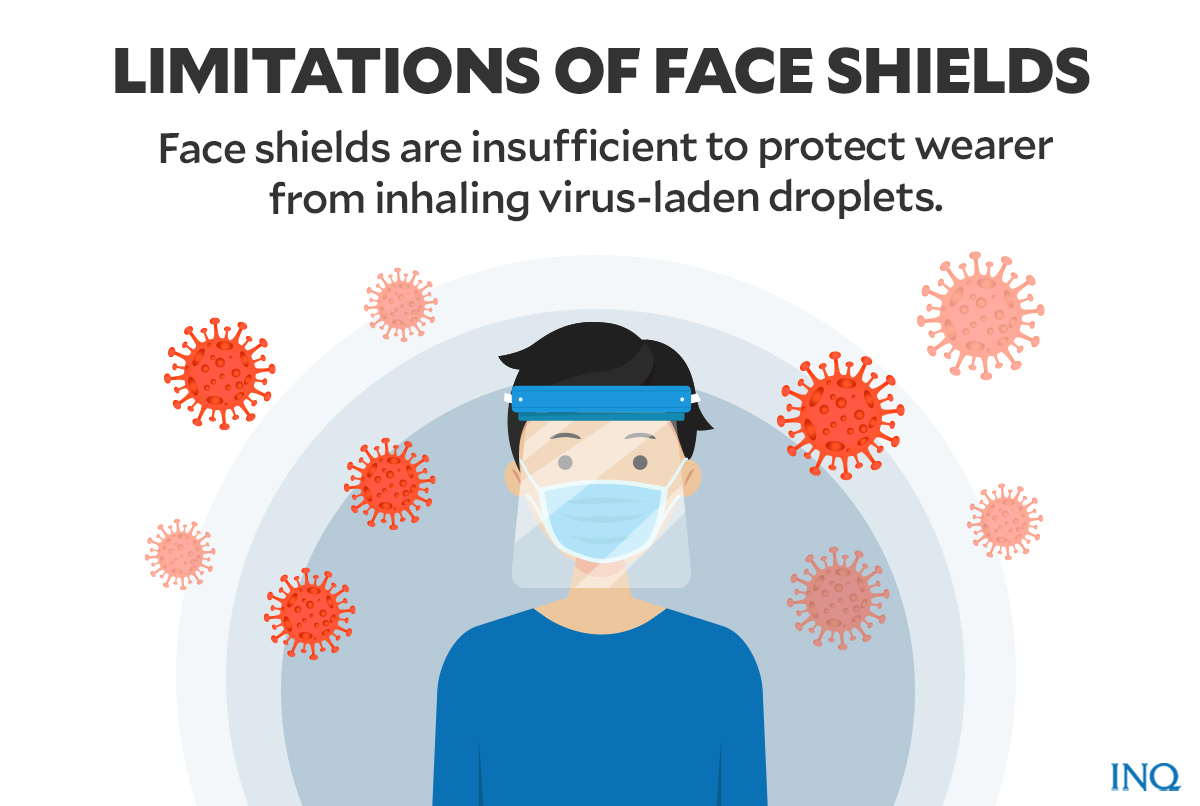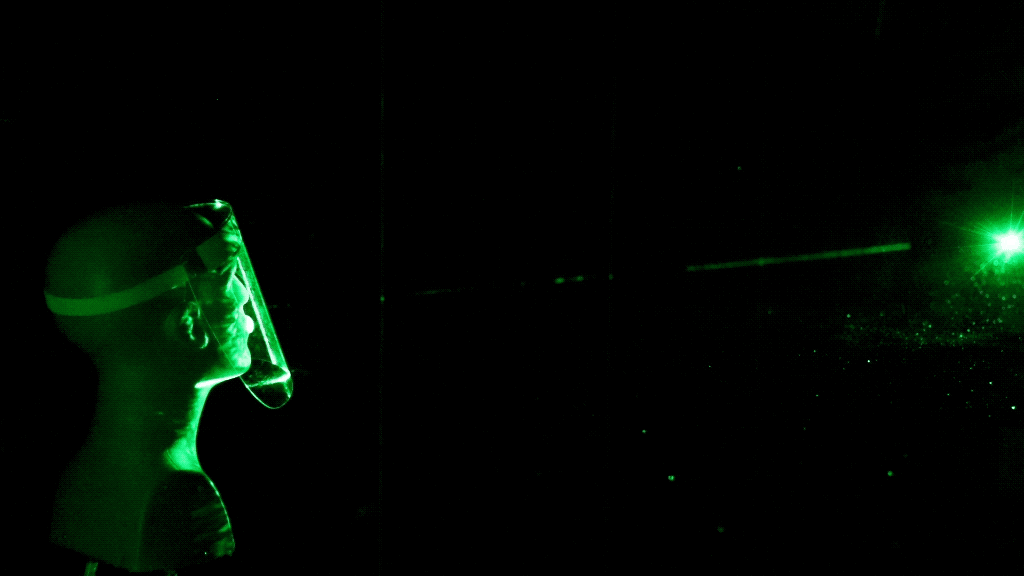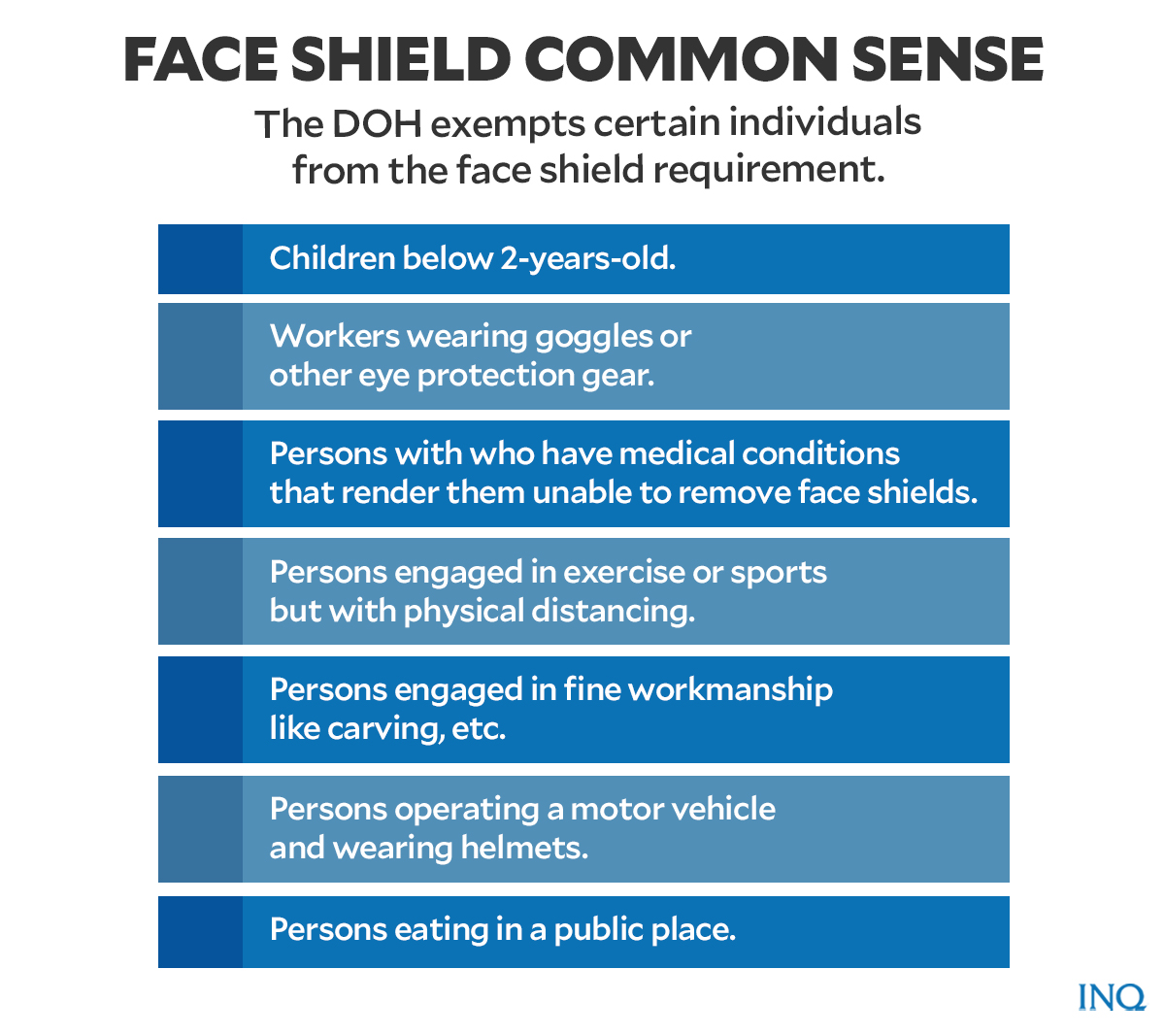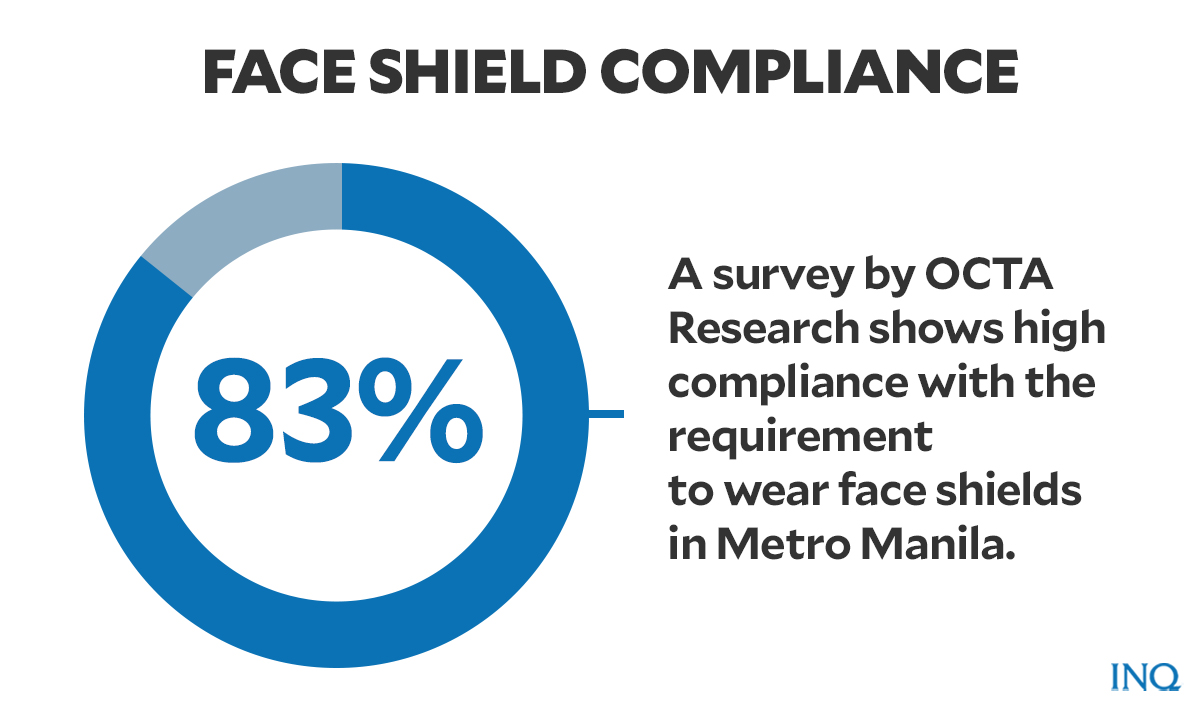Face shields face review as anti-COVID tool
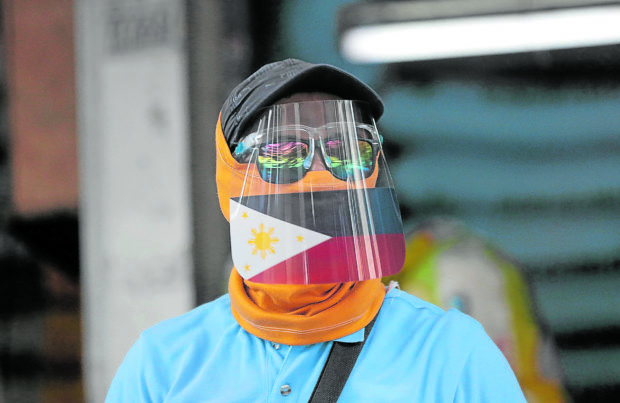
DOUBLE PROTECTION A traffic enforcer wears a face shield on top of his face mask. —GRIG C. MONTEGRANDE
MANILA, Philippines—Some famous faces had launched a seemingly innocuous review of the requirement to use face shields to prevent coronavirus infection.
Manila Mayor Isko Moreno and Senate President Vicente Sotto III, two of the most recognizable faces in Philippine politics, questioned the wisdom or logic of requiring the use of face shields.
Are face shields really effective against the virus or are they simply a business fad riding on the COVID-19 pandemic?
Millions of face shields could have been dumped in the Philippines mainly from China but data are not available from either the Department of Industry or the Bureau of Customs. The Customs bureau keeps track of importation for the purpose of duty collection.
Face shields, being classified as a PPE, are also exempted from taxes so whatever data would be available would be lacking in revenue numbers.
Article continues after this advertisementOn Tuesday (June 15), Health Secretary Francisco Duque III told senators that the department would weigh in and decide whether to retain or scrap the requirement to wear face shields.
Article continues after this advertisementAt a hearing of the Senate committee of the whole on the government’s pandemic response, Duque said the chance of the face shield requirement being scrapped would hinge on the success of the vaccination program.
No need to read between the lines there. It meant the face shield policy will remain.
Gov’t to study ending face shield use once COVID-19 vaccination rate rises – Duque
Recently, Moreno said the government should stop requiring the use of face shields as a protective gear against coronavirus because it simply adds to people’s expenses.
Face shields, said the mayor, should be worn only in hospitals.
Plus, Moreno said, face shields simply add to the country’s plastic wastes.
But Duque and other government officials were quick to oppose Moreno’s suggestion.
Duque nixes proposal to ditch mandatory face shield rule
Roque insists use of face shield help protect vs COVID-19
Moreno, however, insisted that the face shield policy be reviewed in terms of its effectiveness in preventing the spread of SARS Cov2, the highly contagious virus that causes COVID-19.
Moreno has a simple message to enforcers of the policy: Listen to the science.
Isko Moreno to gov’t: Use science to prove face shields protect vs COVID-19
But science is inconclusive when it comes to face shields as a weapon against COVID-19.
Some studies, however, appeared to be in favor of face shields as an effective anti-transmission tool.
An added protection
Several studies done before the era of COVID-19 have suggested that face shields offer only limited protection to their wearers and are insufficient in preventing inhalation of viruses.
A study was made as early as 2014 on health care workers and the effectiveness of face shields as protection against cough droplets. This seven-year-old study was still useful for researchers digging into face shields’ effectiveness against a new virus—SARS Cov2.
Efficacy of Face Shields Against Cough Aerosol Droplets from a Cough Simulator
Researchers found that face shields can “substantially reduce” the exposure of health care workers to influenza-infused aerosol droplets by 96 percent if they are at least 18 inches away from the source of a cough.
The 2014 study also found that face shields reduced surface contamination of a respirator by 97 percent.
The results, however, showed that while face shields can be effective in short-term exposure to large aerosol particles, smaller particles can remain airborne longer and flow around face shields more easily to be inhaled.
Face shields, the 2014 study said, “provide a useful adjunct to respiratory protection for workers caring for patients with respiratory infections.”
“However, they cannot be used as a substitute for respiratory protection when it is needed,” the study said.
The 2014 study’s findings are now being widely cited by more recent studies on the pandemic caused by SARS Cov2.
A 2020 article in the Journal of American Medical Association said face shields offer other advantages. Some of these are:
- Being reusable and easy to clean
- Comfort in wearing and protection of portals of viral entry
- Prevention of virus spread by touching of the face
- Visibility of the wearer
Another study published in the journal of Physics of Fluids in 2020 visualized the effectiveness of face shields.
The 2020 study said simulation showed that face shields “initially deflected droplets toward the ground after a cough.”
“But small droplets remained suspended at the bottom of the shield and then floated around the sides,” the study said.
Droplets spread some 0.9 meter to the front and sides of the face shield wearer, it said. “In some cases, the droplets spread backward instead of forward,” the study added.
The World Health Organization (WHO) and the US Centers for Disease Control and Prevention (CDC) said face shields are not replacements for face masks since shields are used only to protect the face, especially the eyes and nose, and prevent its touching.
“At present, face shields are considered to provide a level of eye protection only and should not be considered as an equivalent to masks,” said WHO last December.
Face shields, WHO said, can be considered as a face mask alternative if face masks were unavailable or in cases when individuals have difficulty wearing face masks.
Face shields “may be considered as an alternative” but “they are inferior to masks with respect to droplet transmission and prevention.”
“Face shields have large gaps below and alongside the face, where your respiratory droplets may escape and reach others around you and will not protect you from respiratory droplets from others,” said the CDC.
Pair of protection
The DOH, however, has found a solution to make sure face shields work in preventing transmission—wear them with face masks.
In a statement last June 4, the DOH said wearing face shields and masks are among “non-pharmacological interventions that, when consistently done and observed altogether, will significantly help reduce” coronavirus transmission and infection.
The DOH also cited guidelines from the Philippine Society for Microbiology and Infectious Diseases (PSMID) and UP National Institute of Health (UP-NIH) as saying evidence suggests that using face masks and shields could be effective in preventing “sustained community transmission of the virus.”
Risks and disadvantages
While the mandatory use of face shields was aimed at controlling coronavirus spread, it also was questioned for the risks it brings some individuals who have breathing and vision difficulties and workers in some industries.
In 2020, the DOH recommended that persons with respiratory issues need not wear or use face shields.
“We are not recommending the use of a face shield if a person has specific respiratory issues,” said Health Undersecretary Maria Rosario Vergeire in Filipino.
Memorandum No. 2020-05341 of the DOH provides guidance on face shield use and listed those exempted from the requirement:
- Infants and children below two years old.
- Workers wearing goggles or other barriers for eye protection are required for their current line of work.
- Individuals who are incapacitated, unconscious, or with medical conditions who are unable to remove face shields.
- Individuals engaging in any form of health-enhancing physical activity or sports provided that a physical distancing is observed.
- Face shields may be removed during the conduct of the activity, but must be worn before and after the activity.
- Individuals whose safety or ability to work would be seriously and adversely affected by visual or respiratory impairment due to the use of a face shield.
- People engaged in strenuous activities or work, fine workmanship, operation of vehicles, and active transport.
- Passengers of motor vehicles wearing helmets with full-face visors are exempted from wearing face shields but must wear face shields before and after transit.
- Individuals who are eating and drinking in public spaces. Face shields must be worn before and after eating and drinking.
Aside from health repercussions and safety issues, face shields also have other disadvantages.
READ: Time to drop those face shields?
For some, face shields can be uncomfortable especially during sweltering weather.
Strict mask, face shield rules make Philippine commuters sweat
Dr. Gonzalo Bearman, a hospital epidemiologist and chair of the Division of Infectious Diseases at Virginia Commonwealth University (VCU) Health, also told the AARP that face shields tend to “get steamy and fog up” easily.
The face shield requirement had also become a magnet for smuggling and counterfeiting.
Last May, the Philippine Coast Guard (PCG), National Bureau of Investigations (NBI) and the Bureau of Customs (BOC) discovered P70 million worth of fake face shields in a warehouse in Parañaque City.
https://www.facebook.com/coastguardph/posts/746307172704606
PCG explained that the face shields “did not pass appropriate inspection and may not be declared safe for use by the Food and Drugs Administration (FDA).”
Moreno also cited the environmental effects of plastic wastes and cost as factors that should be considered in the review of the face shield requirement.
One other country
The Philippines is not the only country requiring the use of face shields to prevent transmission of coronavirus.
Last April, the government of Peru announced that face shields are required inside shopping centers, markets, supermarkets, department stores and other enclosed areas.
It was meant to control the spread of coronavirus in Peru.
Compliance among Filipinos
In the Philippines, people were overwhelmingly compliant with the face shield requirement.
OCTA Research’s Tugon ng Masa survey released earlier this year bared that 83 percent of 600 respondents aged 18 and above from Metro Manila wear face shield.
However, the report also found that the percentage of those who “always” wear a face shield when going out is lower at 61 percent.
Only 31 percent said they wear it “most of the time,” 7 percent responding “sometimes” and 1 percent said “rarely.”
On June 15, the DOH reported 5,389 new cases of COVID-19, driving the nationwide count to 1,327,431 including 56,063 active cases, 1,246,405 recovered patients, and 22,963 deaths.
TSB
For more news about the novel coronavirus click here.
What you need to know about Coronavirus.
For more information on COVID-19, call the DOH Hotline: (02) 86517800 local 1149/1150.
The Inquirer Foundation supports our healthcare frontliners and is still accepting cash donations to be deposited at Banco de Oro (BDO) current account #007960018860 or donate through PayMaya using this link.
